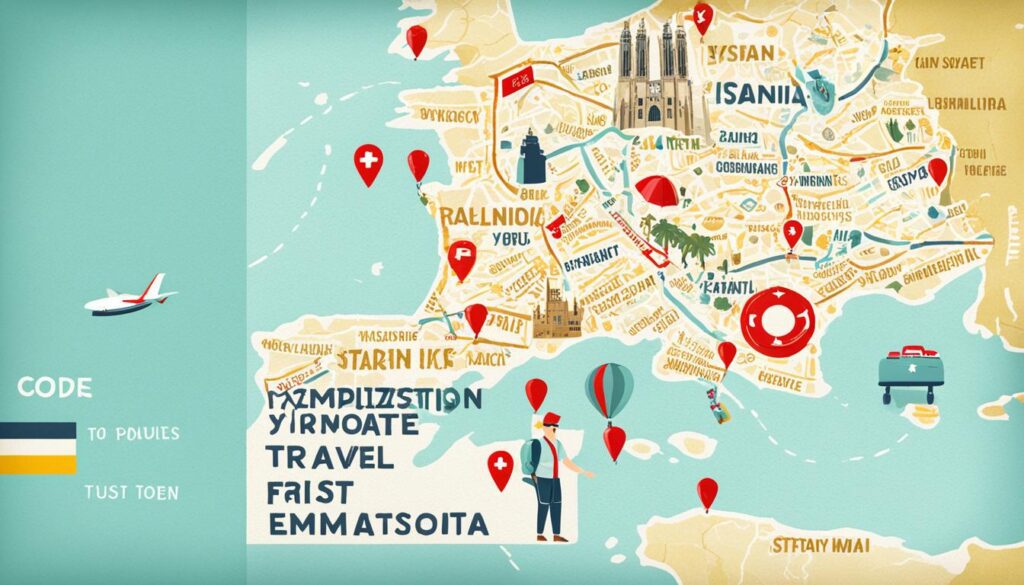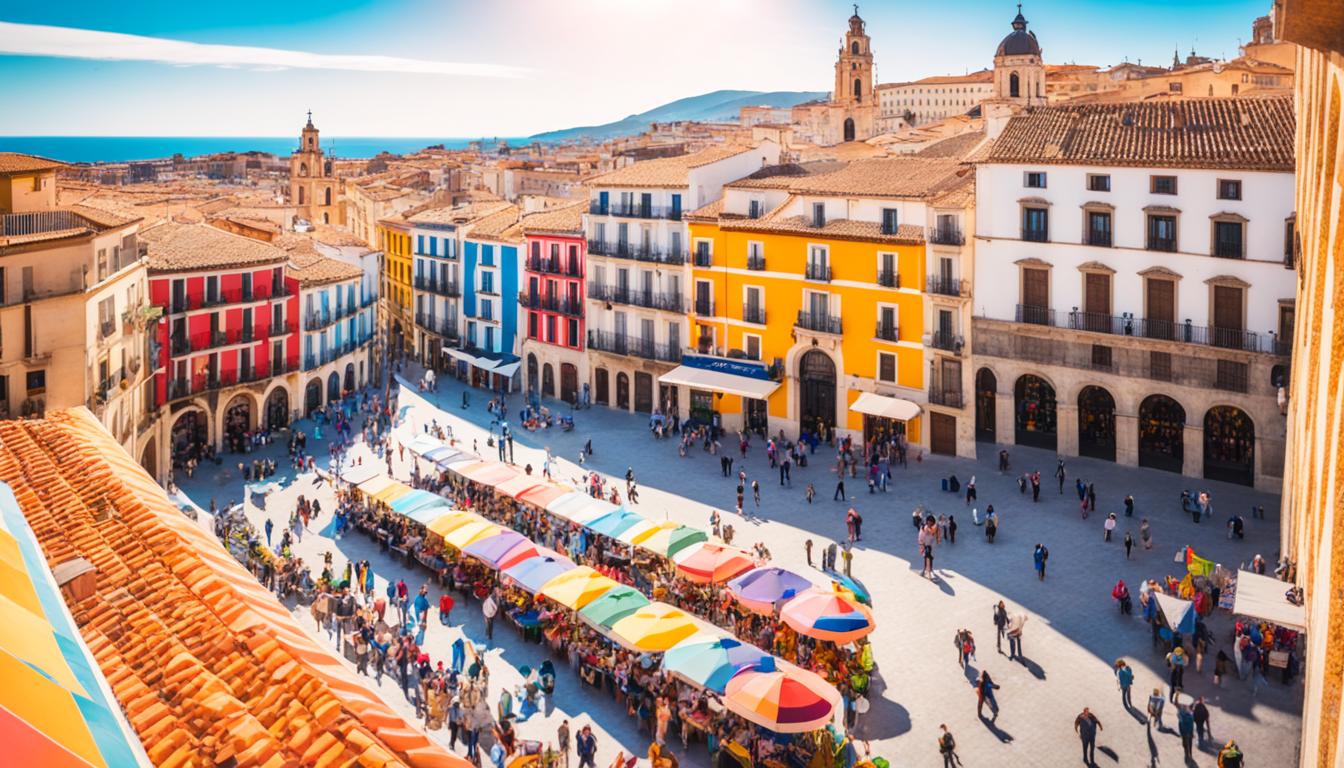Get ready for an amazing trip through Spain’s vibrant culture, beautiful landscapes, and delicious food. This guide is perfect for both first-timers and experienced travelers. It gives you all the travel tips for Spain you need for an unforgettable vacation. You’ll learn the best times to visit and how to get around using Spain’s great public transport.
Key Takeaways
- Discover the best times to visit different regions of Spain based on weather and seasonal events
- Explore top attractions in major cities like Madrid, Barcelona, and Granada
- Uncover lesser-known destinations that offer unique cultural and outdoor experiences
- Utilize Spain’s efficient public transportation system to get around with ease
- Understand Schengen Visa requirements and prepare for potential travel challenges
Decide When to Visit Spain Based on Region and Climate
Spain’s climate changes with each region, making the best visit time vary. You can choose from sunny beach vacations or mild shoulder season trips. Knowing the weather in each area helps plan your trip perfectly.
Southern Spain: Hot Summers, Ideal for Beach Vacations
Andalusia in southern Spain gets very hot in summer, often over 100 degrees Fahrenheit. June to August is best for beach trips along the Costa del Sol. But, the heat can be too much for some, so spring and fall are a good choice.
Northern Spain: Pleasant Summers, Shoulder Season Deals
Northern Spain, like the Basque Country, has cooler summers, in the 70s Fahrenheit. Spring (March-May) and fall (September-October) are great for fewer crowds and lower prices on places to stay and flights.
Winter Conditions Vary by Location
Winter in Spain changes a lot by region. Southern areas stay mild, rarely under 50°F. But, central and northern parts get cold and wet. Winter (November-February) is good for city trips in places like Madrid, with fewer people and lower prices.
| Region | Best Time to Visit | Weather Highlights |
|---|---|---|
| Southern Spain (Andalusia) | June-August | Hot summers, ideal for beach vacations |
| Northern Spain (Basque Country) | March-May, September-October | Pleasant summers, shoulder season deals |
| Nationwide | November-February | Mild winters, smaller crowds and savings |
Think about Spain’s climate to pick the best time to visit and plan your trip. Whether you want sunny beaches or historic cities, Spain has something for every season.
Determine the Length of Your Spain Itinerary
Planning your Spain trip means thinking about how long you’ll stay. The time you have will affect how much of the country you can see.
A minimum of three to five days is a good start for first-timers. This lets you see a few major cities and their highlights. But, for a deeper dive, around 12 to 15 days is better. It gives you enough time to explore several areas and really get to know Spain.
| Trip Length | Suggested Itinerary |
|---|---|
| 1 week | Focus on one or two major cities, such as Madrid and Barcelona, with possible day trips |
| 2 weeks | Explore key highlights, including Madrid, Andalusia, and Barcelona |
| 4 weeks | Experience the entirety of Spain, including northern and southern regions |
Think about what you like and how much time you have when planning your trip. For example, a month lets you really get into one area or follow the Camino de Santiago. With just a week, stick to a couple of big cities and plan day trips.
No matter how long your Spain trip is, planning well is key. Make a good itinerary to make the most of your time. This way, you won’t miss out on the best spots and cultural experiences.
Explore Spain’s Top Attractions in Major Cities
Spain’s big cities have lots of must-see spots that draw visitors from all over. You’ll find everything from the famous Royal Palace in Madrid to the stunning La Sagrada Familia in Barcelona. These places mix history, architecture, and culture in a unique way.
Madrid: Royal Palace, Plazas, and Parks
In Madrid’s heart, the Royal Palace shows off Spain’s royal past. It has over 2,000 rooms, 50 of which you can see. This palace lets you peek into the lives of Spain’s monarchs.
Close by, Madrid’s lively plazas like Puerta del Sol and Plaza Mayor await. And don’t miss the peaceful Parque del Buen Retiro, a beautiful park in the city.
Barcelona: La Sagrada Familia, Picasso Museum, and Beach Life
Barcelona is famous for its stunning buildings, culture, and beaches. The Sagrada Familia, by Antoni Gaudí, is a top spot, visited by over 3 million people each year. Art lovers should check out the Picasso Museum, which has many of his works.
But there’s more than just culture. Barcelona’s beaches are perfect for relaxing with their golden sand and the sound of the sea.
Granada: Alhambra, Granada Cathedral, and Royal Chapel
Granada, in the Sierra Nevada mountains, has some of Spain’s most stunning sights. The Alhambra, a UNESCO site, is a must-see, often booked up early. You can also visit the Granada Cathedral and the Royal Chapel, showing the city’s Moorish and Catholic history.
Whether you’re into Madrid’s grandeur, Barcelona’s architecture, or Granada’s history, Spain’s big cities have lots to see and do.
Consider Lesser-Known Destinations
Spain’s big cities like Madrid and Barcelona are well-known, but there’s much more to see. The Sierra Nevada mountains are perfect for hikers. San Sebastian and Bilbao in the north are full of culture. And Cordoba in the south has UNESCO World Heritage sites. Exploring these places can give you special memories.
Hike the Scenic Sierra Nevada Mountains
The Sierra Nevada mountains in southern Spain are a dream for outdoor lovers. Near Granada, they offer beautiful views and tough trails for spain hiking destinations. You can see high peaks, quiet valleys, and villages in the mountains.
Discover the Cultural Richness of San Sebastian and Bilbao
In northern Spain, San Sebastian and Bilbao are full of culture. San Sebastian is famous for its beautiful beaches, top restaurants, and lively spots. Bilbao has the famous Guggenheim Museum and a beautiful old town with great tapas.
Explore the Historic Wonders of Cordoba
Cordoba in southern Spain is a must-see for history fans. It’s home to the UNESCO-recognized Mosque-Cathedral of Cordoba. The city mixes Moorish and Christian styles. You can wander through quiet streets, see beautiful courtyards, and learn about its history.
“Venturing beyond the popular hotspots can lead to unique and memorable experiences in Spain.”
travel tips for spain: Use Spain’s Efficient Public Transportation
When you visit Spain, using its public transport is a great way to see the country. You can choose from high-speed trains and buses. These options make traveling easy without the need to drive.
Explore Spain by Train
Spain’s AVE trains are perfect for traveling between big cities. They can take you from Madrid to Barcelona in just 2 hours and 40 minutes. Or from Barcelona to Seville in under 5 hours. With over 15,800 kilometers of tracks, the rail network is huge and busy.
Utilize Spain’s Comprehensive Bus Network
For shorter trips or reaching rural areas, buses are a good choice. Buses link towns and cities all over the country. Companies like Alsa and DAMAS offer reliable service. You can plan your bus trips with websites like Movelia.es.
Navigate Cities with Metro and Tram Systems
In cities like Barcelona, Bilbao, and Madrid, the metro makes getting around easy. Barcelona and Alicante also have trams to help you move around.
Using Spain’s public transport saves money and helps the environment. With some planning, you’ll get around Spain’s transportation easily and efficiently.
| Transportation Option | Key Details |
|---|---|
| High-Speed AVE Trains | – Connects major cities like Madrid, Barcelona, and Seville – Speeds up to 310 km/h (193 mph) – Part of Spain’s extensive 15,847 km rail network |
| Buses | – Extensive network reaching rural areas – Companies like Alsa and DAMAS provide reliable service – Websites like Movelia.es help plan bus travel |
| Metro and Tram Systems | – Available in cities like Barcelona, Bilbao, and Madrid – Tram systems supplement metro in some cities – Efficient for navigating cities on foot |
“Spain’s efficient public transportation network makes it easy to explore the country without the hassle of driving.”
Stay in the City Center for Convenience
For a great Spain trip, book a place to stay in the city center near top sights and transport. Best places to stay in spain are in historic districts that are easy to walk around. You’ll find many spain city center hotels, from hostels to big-name hotels.
Walkable Historic Districts
Spain’s historic city centers are charming and full of life. Staying in the middle lets you walk to local shops, restaurants, and cultural spots easily.
Diverse Accommodation Options
Looking for a cheap hostel or a fancy hotel? Spain city center hotels have many choices for your budget and style. They also offer pools, spas, and dining to make your stay better.
Family-Friendly Accommodations in Barcelona
If you’re visiting spain family travel spots, especially Barcelona, find a place that fits your family. These spain city center hotels have big rooms, family suites, and things for kids to enjoy.

“Staying in the heart of Spain’s historic cities allows you to fully immerse yourself in the local culture and experience the vibrant energy of these destinations.” – Jane Doe, travel writer
Understand the Schengen Visa Requirements
If you’re a U.S. citizen planning a trip to Spain, you should know about the Schengen visa requirements. The Schengen Zone includes 27 European countries, including most of the European Union. With a Schengen visa, you can travel freely among these countries.
But, there are rules about how long you can stay in the Schengen area within 180 days. It’s key to know these spain visa requirements and the schengen visa process. This will make your trip through europe travel visa smooth and worry-free.
- Spain joined the Schengen Zone in June 1991, along with 28 other countries.
- The Schengen Visa lets visitors stay in Spain and the Schengen area for up to 90 days.
- People from EU countries and some non-EU countries don’t need a Schengen visa for stays under 90 days.
- About a hundred countries, mainly from Africa, Asia, the Middle East, China, India, and Russia, need a Schengen visa to visit Spain.
- The cost of a Schengen visa for Spain is €80. Children between 6-12 years old pay less, and kids under six get it for free.
The ETIAS system will start in mid-2025, making entry into Europe easier. The EES system, which will replace traditional passport stamping, is set for the second half of 2024. It might begin around October 2024.
“Spain receives dozens of millions of tourist arrivals annually, making it one of the most visited countries globally.”
Knowing the spain visa requirements and schengen visa process helps you have a smooth and fun europe travel visa experience in Spain.
Prepare for the Less Glamorous Side of Travel
Spain is a safe and developed country, but there are things to keep in mind. Getting comprehensive travel insurance is key for emergencies, illnesses, or theft. Pickpocketing and petty crime are common in places like Barcelona. So, keep your things close, carry less cash, and don’t show off expensive items.
Travel Insurance and Safety Precautions
Before you start your trip to Spain, get a good travel insurance policy. It will protect you financially and give you peace of mind. Make sure it covers medical costs, trip cancellations, and lost or stolen items.
- Look into travel insurance companies like World Nomads or Insure My Trip.
- Check that your policy covers the activities and places you’ll visit.
- Sign up for the Smart Traveler Enrollment Program (STEP) for US citizens to get safety updates.
Pickpocketing and Petty Crime Awareness
Even though Spain is safe, watch out for pickpocketing and petty crime. These issues are more common in tourist spots. So, stay alert and keep your valuables safe.
- Only take what you need and keep your bags and valuables close.
- Don’t show off expensive jewelry or gadgets, as it can attract unwanted attention.
- Know the local currency and exchange rates to carry less cash.
- Be careful on public transport, especially in crowded places like metro stations.

By being proactive and following these tips, you can have a great time in Spain without worrying too much about safety.
Conclusion
Spain is full of amazing things to see, from beautiful buildings and deep history to tasty food and lively culture. By using these key Spain travel tips, you’ll get ready for an unforgettable trip. Whether you’re there for a week or a month, this guide will help you pick the best time to go, plan your trip, get around the country, and have a safe and fun vacation.
Spain has everything from stunning landscapes and famous museums in cities like Madrid and Barcelona to secret spots like the Sierra Nevada Mountains and historic Cordoba. This guide focuses on safety, making things easy, and diving into the culture. It’s a complete checklist for a great trip to Spain.
So, start planning your trip to Spain now. Get ready to be amazed by the stunning views, delicious food, and friendly people. The memories you make will stay with you forever.

